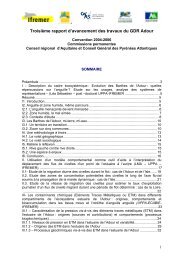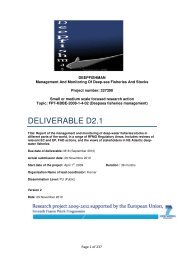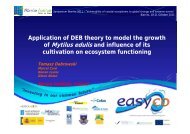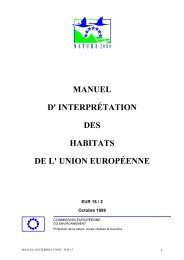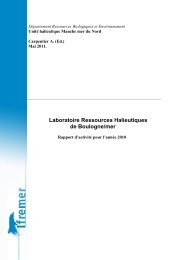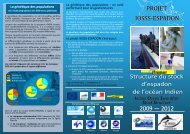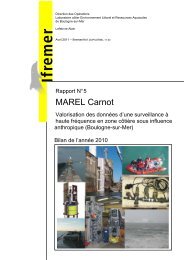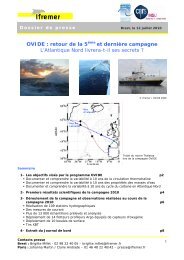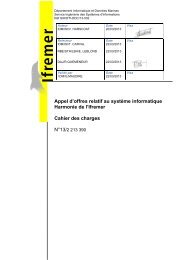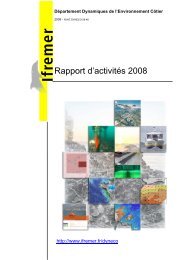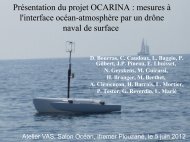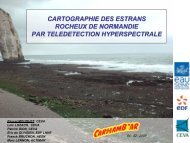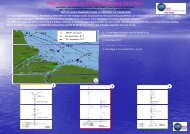Project Deliverable D50 Report on Best Practices Workshop - Ifremer
Project Deliverable D50 Report on Best Practices Workshop - Ifremer
Project Deliverable D50 Report on Best Practices Workshop - Ifremer
You also want an ePaper? Increase the reach of your titles
YUMPU automatically turns print PDFs into web optimized ePapers that Google loves.
4.2.2.3 Debriefing<br />
The following text was issued by the participants to the sessi<strong>on</strong>s.<br />
Some acoustic sensing physical and technological c<strong>on</strong>straints<br />
Abstract: The main distinctive feature of acoustic sensing is the producti<strong>on</strong> of a very large<br />
volume of data in comparis<strong>on</strong> with other standard oceanographic sensors. In additi<strong>on</strong>, active<br />
sensing requires a higher power supply than passive sensing.<br />
The co-existence of the above acoustic applicati<strong>on</strong>s may pose the problem of overlapping<br />
frequency band occupati<strong>on</strong> that must be addressed by synchr<strong>on</strong>izati<strong>on</strong> processes, spatial<br />
separati<strong>on</strong> and software based-soluti<strong>on</strong>s.<br />
The sensing strategy will be driven by the spatial and temporal scales of investigati<strong>on</strong>, e.g.<br />
from l<strong>on</strong>g-term acoustical tomography applicati<strong>on</strong>s to the detecti<strong>on</strong> of geohazard events, from<br />
the detecti<strong>on</strong> of individual zooplankt<strong>on</strong> specimens to the imaging of the scattering layers.<br />
In the case of standal<strong>on</strong>e observatories, the power supply, computati<strong>on</strong>al load, data storage<br />
and transmissi<strong>on</strong> (acoustic modem, satellite link, etc.) may be limiting factors for quasi realtime,<br />
l<strong>on</strong>g time series acquisiti<strong>on</strong> and processing for the whole sensor package.<br />
In the case of cabled observatories, the raw and/or processed data streams generated by the<br />
simultaneous use of different acoustic and n<strong>on</strong>-acoustic sensors to land-based or moored<br />
platform servers may be limited by the data link capacities (copper or optic fiber cables),<br />
related to the distance and the envir<strong>on</strong>ment.<br />
Other issues to be addressed:<br />
- Calibrati<strong>on</strong> procedures (standardizati<strong>on</strong>, auto-calibrati<strong>on</strong>, in situ).<br />
- Standardizati<strong>on</strong> of raw and processed data format (standardized by ICES).<br />
- Bio-fouling, fouling.<br />
Propositi<strong>on</strong> of input from dem<strong>on</strong>strati<strong>on</strong> missi<strong>on</strong>s<br />
Abstract: The DM output will provide informati<strong>on</strong> and knowledge to be implemented in<br />
ESONET. Nevertheless, they cannot cover the full spectrum of acoustic applicati<strong>on</strong>s such as<br />
passive acoustic tomography, geoacoustic characterizati<strong>on</strong> of gas loaded sediment, active<br />
tracking of marine mammals or plankt<strong>on</strong> and fish m<strong>on</strong>itoring.<br />
INPUT from LIDO DM: implementing a modular architecture for a real-time acoustic data<br />
management in ESONET observatories.<br />
The objectives of PAM (Passive Acoustic M<strong>on</strong>itoring) in LIDO, in terms of acoustic and<br />
bioacoustic data management is the l<strong>on</strong>g term m<strong>on</strong>itoring and assessment of the<br />
anthropogenic sources <strong>on</strong> marine organisms, especially cetaceans, implying the real-time<br />
detecti<strong>on</strong>, classificati<strong>on</strong> and tracking of the sources.<br />
The stream of data coming from the observatory is directed to a server that distributes it to<br />
preprocessing servers where the first filters are applied as well as where a further specific<br />
analysis of the data is performed. A dedicated server compresses and stores the raw data. The<br />
processed data is then sent to another stati<strong>on</strong> where <strong>on</strong>e server allows the safe public access to<br />
the low-resoluti<strong>on</strong> data (compressed in MP3 format for <strong>on</strong>line display and outreach) and<br />
another <strong>on</strong>e offers the access to high-resoluti<strong>on</strong> data to registered users. Both servers are<br />
separated for safety reas<strong>on</strong>s and spam/virus protecti<strong>on</strong>.<br />
<str<strong>on</strong>g>Deliverable</str<strong>on</strong>g> #50 - update October 2010 10



